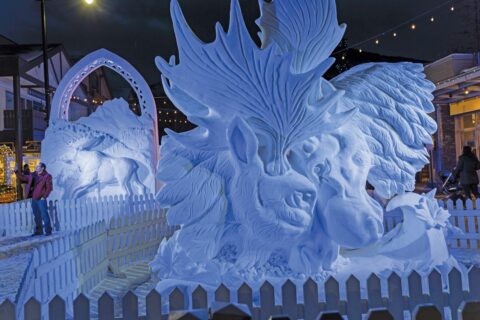December 5, 2022 • Mountain Living
‘Tis the Season: A Holiday Decorating Guide for the Bow Valley
By Kate Barker with Nick de Ruyter, Program Director for WildSmart
It’s the most wonderful time of the year. The mountains look dashing with fresh snowfall, the winter activities are happening in full swing, and the townsites are decorated with twinkling lights to celebrate the season. While the human residents of the Bow Valley are celebrating the holidays, it’s important to remember the animal residents who still need to navigate through their home.
“During the fall rutting season, which normally runs from September to December, male elk and deer are more aggressive and animated, swinging their heads around, rubbing against trees, marking their territories, and showing dominance,” says Nick de Ruyter, Program Director for WildSmart. “This results in a greater chance of getting their antlers tangled in loose hanging decorations and strings of lights.”
So what can you do to celebrate the season, enjoy your holiday lights, and keep wildlife safe? Here are some best practices for decorating so the holidays can be enjoyed by everyone!
Deck the Halls
When decorating with holiday lights, aim to hang them 3 metres or 10 feet off the ground. Consider hanging lights on the roof of your house or high in trees where elk and deer can’t reach. When strings of lights are wrapped around low bushes, our neighbourhood ungulates may get tangled
in them.
While you’re up there, ensure strings of lights are secured tightly to buildings so they don’t sag. Avoid stringing lights between multiple trees or across open spaces. Again, these are great traps for antlers on unsuspecting animals as they wander through your yard. De Ruyter also recommends waiting until after Nov 30 to put up decorations, as this is when the rutting season is over for our local deer
and elk.
Reindeer Crossing
Outdoor lights don’t have to have wires and cords outside. Consider hanging lights inside your windows to get a lovely glow. Laser and light displays can light up your house in fun colours without hanging strings. Using cord-free decorations will also ensure animals don’t get caught up in extension cords or other wiring.
Decorating for the holidays is also a good time to do a walk-through of your property to look for other potential wildlife entanglement hazards. More than just holiday decorations, wildlife can also get tangled in hammocks, rope, wire, fencing, and tarps. Some have even gotten buckets stuck on their heads!
Silent Night
There’s nothing as beautiful as a crisp, still winter’s night. While holiday lights help add life to the short hours of daylight this time of year, they don’t need to be on all night to bring joy to those around us. Consider putting lights on automatic timers so they turn off overnight. This ensures they won’t disturb nocturnal animals like flying squirrels, bats, and owls, who rely on the darkness to go about their business. Holiday lights can make it easier for prey animals to escape as they can better see these predators coming. As a result, nocturnal animals waste more energy in the colder season when they need to conserve it most.
Putting lights on timers will also reduce energy consumption, which will be a nice little Christmas bonus on your next power bill. Timers are cheap and easy to install, so there’s really no reason to keep the lights on all night.
Let it Snow
In addition to saving money, reducing energy consumption during the holidays is just better for the planet. LED bulbs last longer and use less energy than traditional lights, and although they may be slightly more expensive to purchase, they reduce electricity bills in the long run. They also don’t heat up as much as regular bulbs, which means they’re a reduced fire hazard.
There have been a lot of advancements in solar power over the years, and holiday lights that run on solar units are becoming more popular and affordable. Using solar powered lights can be an environmentally friendly alternative to traditional lights, and they can be a festive and fun way to celebrate the holidays.
Run Rudolph
There’s a reason Santa’s lead reindeer has a bright red nose. Nocturnal animals have retinas that are dominated by rod cells, which respond more strongly to blue than red light. This means they are less likely to see the colour red and are less likely to be disturbed by red lights. This helps Santa fly around at night without causing issues, but it also helps animals close to home.
Red or yellow lights also have a longer wavelength and are less visible to most species. Think about how long it takes your own eyes adjust to a bright headlight verses a red light. When choosing lights while decorating your home, consider coloured strings over white ones. The colours add a jovial look to your home, and they have less impact than white lights on local wildlife.
From all of us here at Mountain Real Estate, we wish you the very best this holiday season!
“A quick reminder for residents of the Bow Valley to take a moment and plan for any wildlife that may visit your yard during the holidays. Let’s keep our yards looking festive and our wildlife free of decorations this year! Happy Holidays!” Nick de Ruyter, Program Director for WildSmart



